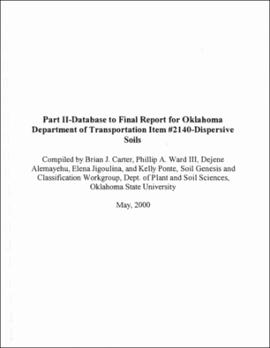| dc.description.abstract | Oklahoma Department of Transportation (ODOT) personnel have problems associated with dispersive soils during road construction and maintenance in several areas of the state (Fig 1.). Rills, pipes, and erosion of roadwyas, embankments, and bridge approaches affected by dispersive soil require maintenance and can become driving hazards if repairs are not made. Staff members at ODOT identified a need for information about dispersive soils in Oklahoma based on economic and safety issues. ODOT Item #2140-Dispersive Soils is a research project concerning 1) the locations of dispersive soils in the state, 2) the physical, chemical, engineering, and mineralogical properties of dispersive soils in the statem and 3) procedures to reduce the amount of dispersion in soils of Oklahoma affected by dispersion. ODOT Item #2140-Dispersive Soils is a cooperative effort of ODOT, the Soil Genesis and Classification Workgroup of the Plant and Soil Sciences Department at Oklahoma State University (OSU) and the Natural Resources Conservation Service of the United States Department of Agriculture (NRCS-USDA). Fieldwork, laboratory analyses, and data interpretation involves workers from ODOT, OSU, and NRCS-USDA. Preliminary work included identification of soil series of dispersive nature from county soil surveys and sampling ~150 soil horizons at type locations of soil series affected by dispersion for counties in Oklahoma that have dispersive soils. Results of laboratory analyses of preliminary samples for dispersive characteristics, were important factors in the selection of soils to be included in the actual project. The final project includes analyses of 151 soil horizons from 23 soil profiles sampled in several different areas of Oklahoma (Table 1 and Fig. 2). The soil profiles sampled for the project formed from a variety of parent materials, including alluvium, shale, sandstone, and limestone (Table 2). Soil pits dug with backhoes provided access to soil profiles for photographs, soil profile descriptions, and sampling of described soil horizons. Part II of the final report for the study contains data collected for each soil horizon in the field and in the laboratory. Laboratory personnel at ODOT concluded double hydrometer, pinhole, crumb, liquid limit, and plasticity index tests on ~100 subsoil horizons from the sampling locations. Personnel at OSU conducted chemical and mineralogical tests on all the soil horizons sampled and prepared the final report for the project, and personnel from NRCS-USDA assisted in identification and sampling of the 23 locations for the project. A description of the database follows the section contianing citations for procedures used to analyze soil samples. | |
